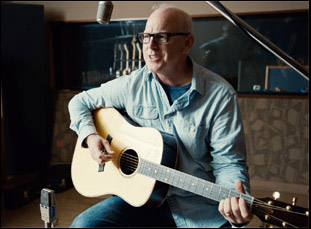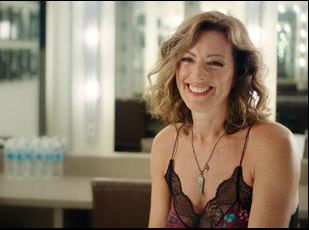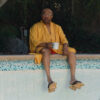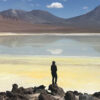“Everything I’ve done is a figment of imagination – it’s just got to rhyme,” Gordon Lightfoot says at one point in Martha Kehoe and Joan Tosoni’s loving tribute to the singer/songwriter “If You Could Read My Mind,” showing his flair for the poetic even when it doesn’t involve homonyms. Yet while a long line of musicians ranging from Steve Earle and Sarah Mclachlan show up to sing his praises, Lightfoot is the last to consider himself much of an artist, making a film about him potentially fraught when speaking about his many accomplishments doesn’t come naturally.(As his wife admonishes in an early scene when he can’t bear to look at an early clip of himself singing, “You don’t see all the beauty for yourself.”)
While a story of having scrambled eggs with Joni Mitchell and Richie Havens may have been just another breakfast for him and late nights jamming with Bob Dylan may be memories that are too hazy now to remember, Lightfoot, who plays a 12-string guitar so he could go an octave higher than most, gets a film that places him where he should be at the heights of the ‘60s and ‘70s folk scene and as one of the true breakthrough artists from Canada whose songs found great international success. Kehoe and Tosoni show how well his music travels, cleverly devising sequences that show various artists covering his songs in a variety of styles while taking Lightfoot back to his old haunts in the Ontario suburb of Orillia where he grew up or the Yorkville district of Toronto where he played club gigs as he worked a day job at the Royal Bank, waiting to be discovered.
Although the film’s title references his greatest hit, “If You Could Read My Mind” gets inside Lightfoot’s head to describe the creative process behind so much of his other music that spoke to so many, even if it involved an isolating, all-consuming writing process and as the musician candidly untangles a love/hate dynamic with the act of creation, Kehoe and Tosoni capture all the sparks of both creating the music and the effect it has on people. After a triumphant premiere in Toronto last summer at Hot Docs, “Gordon Lightfoot: If You Could Read My Mind” is now making its way around the world in virtual cinemas and the co-directors shared how they got their occasionally salty subject to be so open, structuring the film around the music and why their favorite screening of the film might’ve been the most private one.
Joan Tosoni: We’ve known and worked with Gord for a few years, [since] we did a documentary in the early ‘90s about Canadian country and folk music. Over the years, a trust developed between us and a lot of people have wanted to do a documentary and he never said yes. He wasn’t ready to do it, but when he turned 75, he finally said, “Yeah, it’s time to do it,” but it took us a few years to actually get the funding for it.
The opening of the film is quite memorable when he watches an old video and winces – it’s lighthearted, but was it a challenge to get him to talk about the past?
Martha Kehoe: Yeah, that’s something we spoke about with him beforehand. To be fair, he had given us a pretty good interview in that earlier project and Barry Harvey, his manager at the time, said, “Wow, I’ve never seen him open up like that,” so I guess he did trust us. Joanie was interviewing him then and then I did a lot of the interviews this time around, and we had said to him, “You know what Gord? We’re going to want to talk to you about all of the stuff you don’t usually want to talk about.” [laughs] Because you know how artists are. They want to talk about the next thing and what they’re doing now, so we had said to him, “You know, we’re going to ask you all those questions,” and he was like, “Yeah, I know, I know…” and that was his attitude towards the whole thing. But that first scene, we cut it together with a punchline for humor, so it didn’t leave people feeling worried or upset, but he was pissed off as hell that day. [laughs]
Joan Tosoni: He doesn’t enjoy looking at himself from old videos and he really, truly hates that song, so he was worried we were going to give it an undue focus, which in the end we did. [laughs] But I might add that he was really generous with his time. We spent many days with him walking around Yorkville, and driving around Orillia [where he grew up], which we did before we even got the go-ahead. He was always cooperative and he didn’t love every second of it, but he knew it had to be done, so he was generous with his time.
Martha Kehoe: You also just have to make a few choices before you even start down one way because when you’re making a documentary, you’re paddling a canoe every act, and we made a decision that we were going to make this very much Gord’s film, instead of like going out of our way to interview everybody who could say positive things about him. We decided to spend that money and time with Gord, trying to get his story because we did know it was going to be difficult. But Gord loves action and he likes camraderie. He’s used to being in a group, so I think he just began to enjoy having the boys there, like the camera assistants and the team aspect [of filmmaking] and he very much went through this process as a team member.
Joan Tosoni: And he had nothing to do with what the content of the film was going to be. We made it on our own without his input, but when we finished the film and we were about to open it at Hot Docs in Toronto, we asked him if he would like to see it before other people and he said, “Nope, I’m going to see it with everybody else.” So I think that indicated a fair amount of trust…
Martha Kehoe: But tell Stephen his comment. What did the film have too much in it of, Joanie?
Joan Tosoni: Oh yeah, “Too much jawboning and not enough music.” [laughs]
Martha Kehoe: And honestly, that’s a criticism that’s never been leveled at any of the productions that we’ve done. “Too much jawboning.” We hadn’t even considered it as a possibility. [laughs]
I thought you struck a really nice balance, and in fact, the music really drives the story rather than going year-by-year. Did the structure of this come naturally?
Joan Tosoni: We did that deliberately. We didn’t want to follow a chronological path and it was a challenge because we were concentrating on his songwriting because the songs are what mean so much to people — the words of the songs, the sound of the songs and that’s the effort of Gordon Lightfoot really, which is why we didn’t go so much into his personal life because it was peripheral to the subject, which was the music.
Martha Kehoe: But we knew certain songs were representative of certain parts of his story. Obviously “If You Could Read My Mind” [was] the solitaire diamond that got him into international success, but is also so reflective of his personal life and the issues that he had. In [Gord’s] writing, he is able to bring so many emotions while painting a picture of something quite specific, the way the best poets or authors do. They’re telling a story, but certain flashes of their word use brings other subtexts up to the front. We also wanted to show that dichotomy between the artist and the guy because when you meet him, he’ll be like, “Yeah, I saw the hockey game last night and it was great.” [laughs] So [there’s this question of] who the guy felt he needed to be and who he felt he needed to be as the artist.

Martha Kehoe: Well, we’re good at figuring that stuff out. [laughs] That particular one came together like buttah because we had such great footage, and there’s not a lot of footage of Gord performing “Early Morning Rain” in his young days but we knew we had that one pretty nice-looking clip and we knew that we had that footage of him looking at those planes. It wasn’t until we got it into the edit that we realized that was going to work pretty well together, but we were lucky in that interview where he describes that moment of inspiration [saying a] big Boeing 747 right out of the cloud, and when that happens in the interview, we think right away, “Oh, that’s good,” because you hear the cadence of certain phrases and you know it’s going to be a great setting off point for a clip. The last word before a clip should always be hard, so when he says, “Brand spankin’ new Boeing 747 right out of the clouds,” you just think oh, that’s going to be fuckin’ great. [laughs]
Joan Tosoni: Also, we had the advantage with that song that so many other people had recorded it.
Martha Kehoe: Yeah, we knew those [other versions] were out there.
You seem to know where everything is because there’s this rare material of him singing in his church’s choir as a boy and that footage from him in his early days playing at the Riverboat when I can’t imagine people were shooting all that much film of him. What was it like to get your hands on that?
Joan Tosoni: Well, the Riverboat footage was a real find. One of our researchers dug that up. It was an old promotional video for one of our national train companies, and we’ve seen a lot of stuff with Gordon, but not that, and when we saw that, we went, “Holy man,” because there is no other footage of him performing at the Riverboat.
Martha Kehoe: Yeah, that’s exciting and [I should mention] our editor Alex Shuper, who has a lot of credits in music docs and someone Joanie and I both wanted to work with because he’s very talented and he’s like a headbanger type. He didn’t know Gord as well as Joan and I, so we knew he would bring some new eyes to things. Joan and I tend to agree a lot, so you want to have somebody in there who’s going to really challenge you and make you think and he very cleverly incorporated other B-roll of the Riverboat that we had — nothing with Gord, but he managed to make some really cool things work there and that [sequence] was one of the things when Alex was doing some work while we still were shooting and we came and we saw the beginnings of that section and we were like, “Oh my God, great!” And we were excited.
Did anything happen that changed your ideas of what this could be?
Martha Kehoe: That did for sure. That filled out an area that we were like, “How are we going to make it seem alive?” That’s what we were worrying about. But we also had little bits of archival around and about that were little things that we would try sometimes in the edit suite. We developed an electronic folder in the edit suite called “Land of Misfit Toys” where we had things we liked, but we couldn’t fit them into our narrative. There’s a little piece that probably doesn’t resonate for Americans, but where Gord gets up to accept an award in the middle of “Wreck of the Edmund Fitzgerald” from a very famous Canadian named Sam Schneiderman, and Joan and I were having a drink at night and we were looking at “Misfit Toys” stuff and I said, “I think we can put that clip over from where Alec Baldwin’s comment about ‘Wreck of the Edmund Fitzgerald.” That was something that we wanted to get in because Sam was a real booster of Canadian music in Gord’s day. They were good friends and his store was right next to the Steel Tavern, so there was a lot of Canadian history in that tiny clip. A lot of Canadians have said, “You even got Sam the record man in there!”

Joan Tosoni: We were grateful that [Gordon] had chosen not to see it on his own at home because it was a bit of an overwhelming experience for us, but the audience response was so good, Gord couldn’t almost help but like it. [laughs]
Martha Kehoe: Yeah, Hot Docs was amazing. Working our whole careers in Canadian film and television, Joanie and I are actually extremely fortunate to have been on a lot of shows that have won favor and got notoriety, but nobody’s usually that excited about it. [laughs] The fact there’s a theater full of people weeping and saying, “This is the best movie and we all love it” was a little bit overwhelming, but needless to say we were pleased. We were like queens for a day.
Joan Tosoni: Another highlight for us was [the programmers at] the Doc and Roll Film Festival of London, England approached us and asked to put it in, so we decided to take a trip to London, and what was moving for me was that several people came from different parts of England and were dying to speak to us afterwards — one guy who I talked to for quite a while that night had been a loyal Gordon Lightfoot fan since the ‘70s and still played his songs as a solo artist and he’d traveled quite a distance just to see the film, so it was really gratifying.
Martha Kehoe: But maybe our best audience reaction — and the best for Gord was that Gord belongs to a men’s fitness club in Toronto and he belonged to it for something like 50 years. He goes to the gym every day and he works out and he fills out all his charts and of course, he’s a little bit of a celebrity mascot for the club. It’s all Bay Street guys, mostly, and here’s Gord going around in his little shorts, so as you can imagine, they all have admiration and fondness for him and the people at the club asked if we could do a private screening for the club members in their bar…
Joan Tosoni: He’s also one of the guys, you know?
Martha Kehoe: And he loves being one of the guys. He couldn’t be more thrilled in that situation. So they invited us — and women can go to it, but it was mostly men and they roared at every possible thing. From the beginning when he said, “I hate that fuckin’ song,” they just tore that place apart. They laughed their heads off and when he said [about ending one of his musical partnerships], “It was like every divorce I had after that, it just about killed me,” they were like “Ah hahaha” because it’s a bunch of guys finding that funny. That screening, Gord was like, “Wow, I like the movie now. I’m starting to understand why you made some of the choices that you made.” It’s like, “Thanks Gord.” [laughs] He’s starting to like it.





